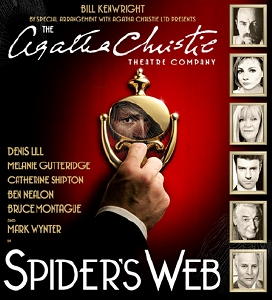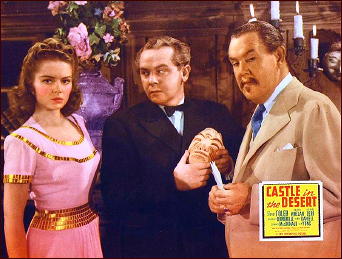September 2009
Monthly Archive
Tue 15 Sep 2009
A 1001 MIDNIGHTS Review
by Marcia Muller:
RUTH RENDELL – The Fever Tree and Other Stories of Suspense. Pantheon, US, hardcover, 1982. UK edition: Hutchinson, hc, 1982. Paperback reprint: Ballantine, 1984.
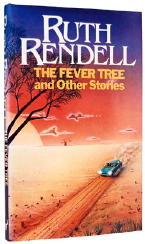
One of the most impressive qualities of Ruth Rendell’s work is her grasp of the dark side of the human character and her ability to portray it in a dramatic and convincing fashion. Whether she is writing a short story, one of her compelling novels of psychological suspense, or an entry in her popular series featuring Chief Inspector Wexford of the British village of Kingsmarkham, she depicts fully fleshedout characters in all their complexity.
The plots work, not so much because of neatly placed clues or clever twists (although these are present, too), but because the underlying motivations are logical and true to the participants’ inner natures.
The Fever Tree is Rendell’s third short-story collection. (The others are The Fallen Curtain and Other Stories, 1976; and Means of Evil and Other Stories, 1979.)
The stories are varied, but all carry the Rendell trademark of evil lying just below the surface of ordinary, even mundane, events. In the title story, a man and his wife are on vacation in an African game preserve, a vacation that is also a reconciliation. The man has been unfaithful and only recently returned to his wife. And as the wife, a childlike woman who insists on breaking the preserve rules, gets out of the car time and time again to look at the animals, terrible thoughts begin to form in both of their minds-thoughts that do not lead to a predictable conclusion.
Likewise, “Thornapple” is a plant, but nothing so exotic as Africa’s fever tree — merely the jimsonweed that appears in many English gardens. James, a young boy, is a bit of an amateur botanist, and poisonous plants particularly interest him.
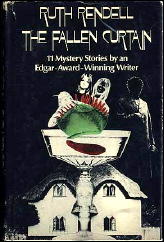
“Not that James had the least intention of putting these poisons of his to use.” But then the accepted order in James’s family is disrupted, causing a great many things to get out of hand.
Things get out of hand quite frequently in the life of the protagonist of “A Needle for the Devil.” As a child, Alice Gibson’s personal devil often “led her to violence.” She learned to control her impulses by practicing handicrafts, but when she goes into nurse’s training, circumstances force her to abandon most of them, and knitting becomes her salvation. Knitting, with all those lovely sharp needles …
This is a well-balanced collection, and the stories included are among Rendell’s best short fiction. (One of her short stories, “The Fallen Curtain,” won the Mystery Writers of America Edgar in 1974.)
———
Reprinted with permission from 1001 Midnights, edited by Bill Pronzini & Marcia Muller and published by The Battered Silicon Dispatch Box, 2007. Copyright © 1986, 2007 by the Pronzini-Muller Family Trust.
Tue 15 Sep 2009
A REVIEW BY DAVID L. VINEYARD:
WILL THOMAS – The Limehouse Text. Touchstone, hardcover & trade paperback, July 2006.
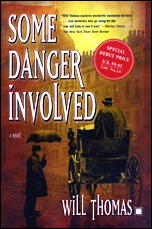
This is the third book in the series by Oklahoma librarian Will Thomas about late Victorian sleuth Cyrus Barker (the ‘Guv’) and his assistant/Watson Thomas Llewelyn who made their debut back in Some Danger Involved followed up by Kingdom Come.
This time out Barker and Llewelyn follow the trail of a pawn ticket that leads them into the shadowy environs of Limehouse, London’s Chinese district, where opium dens and honest shopkeepers meet, and the influence of the Chinese tong societies and their hatchet men haunts them.
The pawn ticket leads them to a rare book that conceals an ancient fighting technique, dim mak, long hidden from the west, and Llewelyn and Barker find themselves caught between a killer seeking the ancient wisdom and the dangers of the growing tension between the British Empire and China as well as the mysterious man at the heart of all the crime in Limehouse, Mr. K’ing (and any reader of Sax Rohmer and August Dereleth’s Solar Pons should have no problem identifying him).
“If what Bainbridge thought is correct, all the deaths that occurred just after New Year may be the work of one killer… the only connection they seem to have had was a book. The book, the book, the Bloody book! Didn’t you say in court it was a boxing manual? Who kills three people over a boxing manual.”
“It’s rather a special manual, Terence,” Barker explained. “It teaches, for one thing, the way to disrupt the body’s internal functions, killing someone without a sign.”
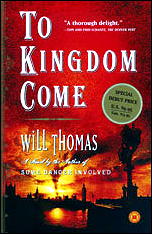
Through the smoky dream-ridden opium dens to the back room blood sports indulged in by the high and the mighty, Barker and Llewelyn hunt a killer and try to keep their heads while preventing virtual war from breaking out in the streets of Limehouse. Israel Zangwill, the author of the classic The Big Bow Mystery even features in the plot. (Thomas often features a historical and often literary figure like Zangwill in the books.)
Limehouse had become enchanted that night. Every wall was festooned with messages in gilt and streamers of red paper and firecrackers. Entranceways that no one had swept for years were now swept and mopped. The drab and mean streets* of the area had now become a fairyland…
Luckily for them, Barker is an expert on all things Chinese, from the lethal razor sharp pennies he carries in his pockets to the martial arts he engages in. He even keeps a courageous little black Pekingese, Harm, who frequently features in the novels plot, as he does here. Before the game is brought to bay Barker will have to fight a battle to the death in one of those back rooms to save both his and Llewelyn’s life.
Will Thomas is an admirer of Sherlock Holmes and Doyle obviously, but also familiar with his Nero Wolfe, and Llewelyn is much closer to Archie than Watson, despite his admiration for Barker, his enigmatic boss.
The books manage a neat blend of action, mystery, and atmosphere that make them a real pleasure to read, as the action moves, the plot twists, and Barker and Llewelyn find themselves in increasingly hot water and trouble. Thomas knowledge of Victorian literature and history also shows in his casual but in depth portrait of his heroes environs.
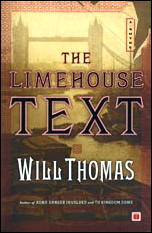
These books are great fun, never letting the research get in the way of the action or plot, Barker and Llewelyn a testy and intelligent match as a team, and the observations of just how close our disparate worlds really are a reminder that the more things change the more they stay the same.
“The Bible is a book. The Koran is a book. Right now, in the Sudan, men are killing themselves over both of them.”
Playful, smart, fast paced, and involving, this is one of the best historical tec series ongoing, and certainly to become a classic. Once you meet them you will want to get to know Barker and Llewelyn and their worlds better.
* Should anyone think they have caught Thomas in an anachronism, the term “mean streets” was first coined by Victorian writer Arthur Morrison to describe London’s less wholesome districts, in the book Tales of Mean Streets (1895). Morrison is probably better known today for his stories about Sherlock Holmes rival Martin Hewitt.
That said, I will grant that in The Limehouse Text Thomas uses the term a number of years before Morrison’s book was published.
The Cyrus Barker & Thomas Llewelyn series:
1. Some Danger Involved (2004).
2. Kingdom Come (2005).
3. The Limestone Text (2006).
4. The Hellfire Conspiracy (2007).
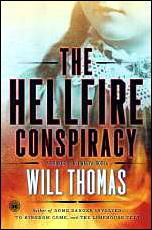
5. The Black Hand (2008).
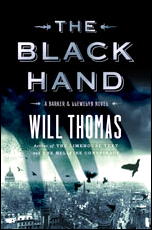
6. “In progress,” according to the author’s blog, August 2009.
Mon 14 Sep 2009
OFF THE RECORD. Warner Brothers, 1939. Pat O’Brien, Joan Blondell, Bobby Jordan, Alan Baxter, Morgan Conway. Director: James Flood.

Joan Blondell plays a reporter (Jane Morgan) in this movie, and so does Pat O’Brien, but he’s the kind of guy (named “Breezy”) who thinks women should stay at home and be married (in this case to him) rather than have a career, especially writing for the same newspaper.
To show him, Jane finds a story on her own – successfully, too, as it produces several headlines and puts a punk hoodlum into prison and his young brother (Bobby Jordan) into reform school. The big boss, though, as big bosses have a way of doing, manages to stay on the outside.
Feeling guilty about the boy in reform school, Jane persuades Breezy to adopt young Mickey. And of course to do that, they also have to get married, although Breezy is the last to know that’s the reason — and the first to object when he finds out.
The first third of this 60-minute movie is in the same dark and gritty mode as many of the Warner Brothers gangster films being made around the same time, and so are the last 15 minutes or so. In between, if it’s not a comedy — young Mickey definitely does not want to be adopted – it is considerably lighter in fare than the rest of the film.
Bobby Jordan made a career out of playing pseudo-delinquents and young toughs on the fringes of the law, including long stints with the Dead End Kids, East Side Kids and the Bowery Boys. In this one, at the age of only sixteen himself, he reminded me of none other than a young Lloyd Nolan, often wearing a felt hat, necktie and a suit jacket that looks a size or two too large for him and trying to look as grown-up as he could.
But to my mind, Off the Record is Joan Blondell’s picture. She uses this film to show off her fine ability as a straight actress as well as a flair for wisecracking comedy. Although she’s largely forgotten today, both of these talents stood her well over a long career in movies and TV, which extended from her debut in 1930 to her death in 1979 at the age of 73.
Mon 14 Sep 2009
REVIEWED BY GEOFF BRADLEY:
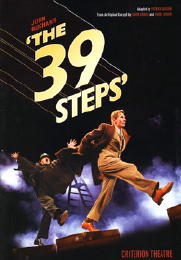
I have had two (relatively) recent trips to the theatre. First up was a belated visit to the West End to catch up with the award-winning production of The 39 Steps based on the Hitchcock film version rather than the Buchan book version.
Four actors (strictly three actors and an actress) take on a variety of roles (strictly one actor is Richard Hannay and the others take multiple roles), and the film is recreated rather hammily and for laughs but quite accurately under the circumstances.
It was a marvelous production and I enjoyed it thoroughly, laughing aloud at times (and I am only rarely a laughing aloud type of person). The production was very similar to the three-man version of The Hound of the Baskervilles which I saw last year but which this production actually preceded (and so should probably take more credit).
I can heartily recommend it any of you who get a chance to see it.
The second play I got to see is And Then There Were None, the third from the Agatha Christie Theatre Company. The company tours each year with a new production — last year was The Unexpected Guest, which I saw, and two years ago they did The Hollow which I missed.
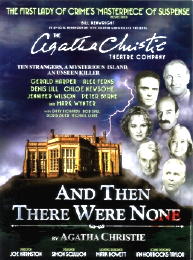
Anyway I caught up with And Then There Were None in Norwich and thoroughly enjoyed it. There’s no point my rehashing the plot, but if you are familiar with it you might like to know that the ending of the book was restored, rather than the different ending that Agatha Christie gave to her play version.
Suffice to say I enjoyed it all. The cast was made up of reasonably well known from television actors including Gerald Harper (bast known as Adam Adamant from the ’60s and Hadleigh from the ’70s), Peter Byrne (best known as Dixon of Dock Green’s son-in-law from the ’50s) and Alex Ferns (best known from Eastenders in the ’00s).
Throw in Denis Lill who was Inspector Bradstreet in Granada’s Jeremy Brett/Sherlock Holmes series and Mark Wynter ’60s pop singer turned actor, and you had a pretty good cast.
Next year’s production, which I shall make every effort to see, is Spider’s Web.
— September 2008.
Mon 14 Sep 2009
STEVE HAMILTON – North of Nowhere.
St. Martin’s; paperback reprint; 1st printing, May 2003. Hardcover edition: St. Martin’s, 2002.
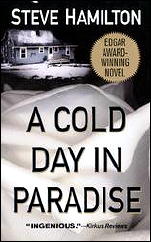
When I went to undergraduate school in Michigan’s famed upper peninsula, there was a popular song (and maybe a movie) called “North to Alaska.” Our version was turned around and became “South to Alaska.” (Maybe you had to be there.)
Anyway, this is the fourth of former Detroit policeman Alex McKnight’s recorded cases, the first of which, A Cold Day in Paradise, won an Edgar. There’s a town in the lower portion of the state called Hell, down around Ann Arbor, and I’ve been there, and I’ve been to Paradise, where this story takes place, up around Sault Ste. Marie, and more in the middle of nothing but trees, trees and more trees, it is hard to imagine.
Well, there is the Lake Superior shoreline, and nearby Tahquamenon Falls. Could the area be the site of the next building boom, for rich down-staters to build multi-room faux-Victorian summer mansions along the lake?
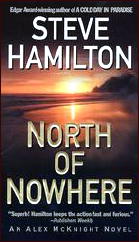
Alex gets involved when a poker party he’s invited to at the last minute is interrupted by gunmen who seem to know how much money the wealthy host (and would-be developer) has in his hidden upstairs safe.
The tale as it develops from there is too long (322 pages) and too talky to be truly hard-boiled, but Hamilton has the knack of pulling the reader into his story with prose as smooth as you hope to live for and yet so seething with underlying tension that it sometimes hurts. McKnight also has a wonderfully uncool and all-but-inept private eye buddy whose loyalty is questioned but comes back answered.
This is a guy’s book — the only women that show up are three or four wives, some faithful and some not. There’s also just enough honest-to-goodness detective work going on to add an extra dimension to a rip-roaring northern woods adventure novel that’s sheer all-out fun to boot.
— May 2003
The
Alex McKnight series —
1. A Cold Day in Paradise (1998)
2. Winter of the Wolf Moon (2000)
3. The Hunting Wind (2001)
4. North of Nowhere (2002)
5. Blood Is The Sky (2003)
6. Ice Run (2004)
7. A Stolen Season (2006)
Mon 14 Sep 2009
REVIEWED BY WALTER ALBERT:
FRANK TALLIS – A Death in Vienna. Random House, trade paperback, May 2007. First UK edition, as Mortal Mischief: Century, hardcover; June 2005.

I’d been eying this novel, set in turn-of-the-century Vienna for some time. When I decided to buy a copy, my local bookshop was out of stock, but a copy was ordered and a week later I settled down to read it.
Dr. Max Liebermann is a follower of the new theories of Sigmund Freud, which puts him in conflict with his superior at the hospital where he is affiliated. He is also the good friend of Detective Oscar Reinhardt, and when a psychic is murdered inside her apartment in a room locked from the inside, with no apparent means of entry other than the door, Oscar invites Max to assist him in his investigation.
Vienna, in 1902, was a center of the arts. Mahler was conducting at the symphony and opera, Gustav Klimt was exhibiting his works at a museum, and the city was rich in cultural events, first-class restaurants and the inevitable conflicts between the conservative past and the new, more open present. Tallis evokes the city with great skill all the while constructing a plot that tests the professional and personal skills of his protagonists.
Series: The Liebermann Papers
1. Mortal Mischief (2005). US edition: A Death in Vienna, Random House, May 2007.
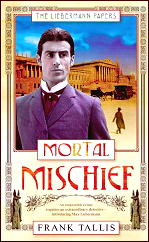
2. Vienna Blood (2006). US edition: Random House, Jan 2008.
3. Fatal Lies (2008). US edition: Random House, Feb 2009.
4. Darkness Rising (2009). US edition: Random House, Mar 2010.
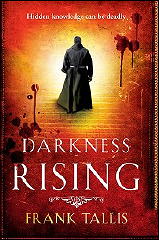
Sun 13 Sep 2009
A 1001 MIDNIGHTS Review
by Marcia Muller:
JOEL TOWNSLEY ROGERS – The Red Right Hand. First published in New Detective Magazine, March 1945. Reprinted many times, in both hardcover and soft. Shown: Pocket 385, pb, 1946; Dell D203, pb, Great Mystery Library #9, 1957.
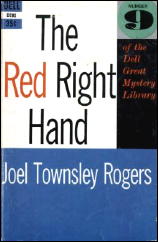
This classic suspense novel has the quality of a hallucination. From the opening paragraph, we are drawn into a strange world where eerie and seemingly impossible events are happening; and as we view them through the eyes of the narrator, Dr. Harry Riddle, we begin, as he does, to believe in their reality and to search desperately for some rational explanation for them.
The story begins after most of the events have taken place, with Riddle trying desperately to puzzle them out as he sits in the study of Adam MacComereau, a professor emeritus of psychiatry at Harvard.
The late Adam MacComereau, we learn. Murder has been done more than once. Various shadowy and frightening events are described, without their chronology or connections being given. There is a woman asleep on a nearby sofa toward whom Riddle feels protective, while also holding back fear of his own insanity. And as he sits there, thinking about the events that have passed, he begins to reconstruct what they really signify.
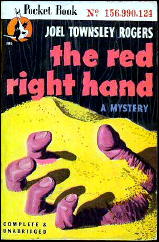
While driving from Vermont to New York City, Riddle had car trouble on a back road; when he finally got under way, he encountered the woman, Elinor Darrie, lost and fleeing through the underbrush. As Riddle tells us, “It was a simple enough incident.”
Elinor and her fiance, Inis St. Erme, were driving to Vermont to be married. On the road they picked up a tramp-a little, twisted man whom Riddle comes to think of as Corkscrew — and when they stopped for a picnic, there was a fight between the tramp and St. Erme. Elinor heard a terrifying scream and fled. Riddle and Elinor investigated the spot and found a quantity of blood, but nothing else.
As Riddle says, “It was such a damned ordinary and commonplace crime, on the face of it.” But other aspects surface — such as St. Erme’ s missing right hand; a mutilated blue hat that Riddle found on the road before he met with Elinor; the noise “like a great frog croaking in the weedy ditch” near where Riddle’s car broke down; and the ugly little man, Corkscrew — who is he and how has he gotten away after apparently doing murder?
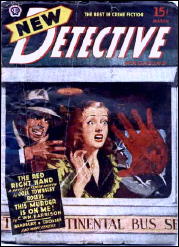
This is a dizzying and confusing novel, but pleasurably so. And when the action has been unraveled, its apparent solution explained, confusion is initiated again, and more action occurs. And when that has been unraveled, its solution stands alone, and the result is stunning indeed.
In thinking over the wonderful experience of reading The Red Right Hand, the reader can only marvel at how the author constructed such a baffling and complex plot without leaving a thread untied. And — corollary to that — how he did so without driving himself as mad as his narrator fears he is becoming.
Rogers, however, did remain sane and capable of writing other memorable novels: Lady with the Dice (1946) and The Stopped Clock (1958). In addition, he wrote reams of fiction for both the pulp and slick magazines, and a first (but less memorable) novel, Once in a Red Moon (1923).
———
Reprinted with permission from 1001 Midnights, edited by Bill Pronzini & Marcia Muller and published by The Battered Silicon Dispatch Box, 2007. Copyright © 1986, 2007 by the Pronzini-Muller Family Trust.
Editorial Comment. As you might recall, I’d intended to post the three Ruth Rendell reviews from 1001M this weekend, but as usual, the real world interfered. I’ll get those uploaded in the next couple of days, I hope, but in the meantime, I thought this alternative choice might be appropriate.
Geoff Bradley’s review of this book, which you can find here, has generated more comments than usual — including my own admission that I’ve yet to read it. Perhaps the book falls into a category that might called Classic Novels That Everyone’s Heard About But Relatively Few Have Read.
If the combination of Geoff’s and Marcia Muller’s reviews don’t tempt you into reading it, if you haven’t already — and I doubt that anyone could say more about the story than Marcia without revealing everything — than nothing will!
As for me, I know when I’ve run out of excuses. I also know where my copy of the Pocket paperback is, and I’ll start reading it this week. You can take that statement to the bank and cash it. It’s as good as gold.
Sun 13 Sep 2009
REVIEWED BY DAN STUMPF:
CASTLE IN THE DESERT. 20th Century-Fox, 1942. Sidney Toler (Charlie Chan), Arleen Whelan, Richard Derr, Douglass Dumbrille, Henry Daniell, Edmund MacDonald, Victor Sen Yung (Jimmy Chan). Based on characters created by Earl Derr Biggers. Director: Harry Lachman.
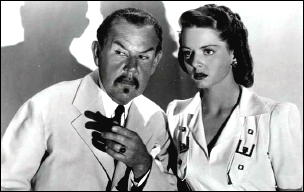
Fox Movie Channel has decided to air the Charlie Chan films after all, and everyone should take advantage of this chance to see a really fine print of Castle in the Desert, Fox’s last Chan film and one of the best, thanks to the astute direction of Harry Lachman.
Lachman was a French Impressionist painter who fled Europe ahead of the Nazis and found work in Hollywood, mostly at 20th Century-Fox. He stayed primarily in B-movies, not all of them much good, but his work showed a consistently interesting visual style and fluid pacing that elevated many a pre-doomed project (such as Dr. Renault’s Secret, a Mad Scientist meller in which Arthur Shields(!) plays a French Gendarme).
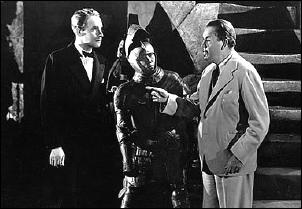
His Dante’s Inferno (1939) is particularly interesting: the film itself is a rather awkward rise-and-fall-of-Spencer-Tracy morality tale, built around ten minutes of silent footage of Hell from an old Italian movie (hence the title), but Lachman’s handling of scenes in Tracy’s fun-house, and a shipboard fire prove more interesting than celluloid Hell itself.
Getting back to Castle in the Desert, it is, as I said, a pretty entertaining effort, what with Lachman’s punchy direction, a clever script (including a surprisingly intelligent use of the old guy-hiding-in-a-suit-of-armor gag) and the presence of Henry Daniell and Douglas Dumbrille, giving it their sinister all as suspects in the game.
Dumbrille especially seems to enjoy himself here, given a part slightly more sympathetic than normal. He was — like Laurence Harvey — one of those actors who never made any claim on our sympathy, but where Harvey came across as emotionally constipated, Dumbrille was always just stuffy; except in his �personal life, where at age 70 he married the 28-year-old daughter of his friend and fellow-actor, Alan Mowbray.
Sun 13 Sep 2009
Posted by Steve under
ReviewsNo Comments
A REVIEW BY DAVID L. VINEYARD:
BRENT GHELFI – The Verona Cable. Henry Holt, hardcover; First Edition, August 2009.
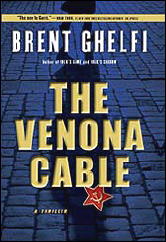
Alexei Volkovoy, aka Volk, is an ex Soviet Military Covert agent, a one-legged man in the bloody kicking contest that is the Russian underworld in the wake of the fall of Communism, and the hero of this and two other novels from Brent Ghelfi.
Tough, smart, ruthless, and human, Volk is a often caught in the crossfire between the former Russian secret police, the underworld, the Americans, and the complex and deadly past of the former Soviet Union.
In The Verona Cable we meet him wounded and on the run in Los Angeles, after a mission has gone terribly wrong. It began back in Russia when an American cinematographer shows up murdered in a warehouse owned by Volk.
After a rough time with the secret police Volk is freed to return home to his lover Valya (like him, an amputee, and victim of Russia’s violent and tragic recent past — and yes, the metaphor is a bit heavy handed, though to give Ghelfi credit he uses it sparingly — the wounded lovers taking shelter in each others arms to make one whole individual …).
Soon Volk discovers the dead American cinematographer was once a Soviet agent operating in the United States during the Cold War like Alger Hiss or the Rosenbergs, and is somehow tied to Volk’s father, a disgraced Soviet pilot who may have defected to the West with a high tech Soviet spy plane when Volk was born. More importantly the so called Verona Cable on the dead man may point to the legendary Source 19, a highly place American traitor who had access as high as the wartime White House.
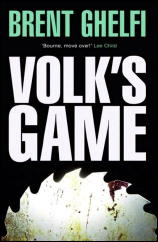
There are secrets that some will still kill to find out.
Which is how Volk finds himself sent to Los Angeles on a quest that is both personal and of interest to the Russians and the Americans, with everyone using him and everyone willing to sacrifice him for the truth — or to conceal it. A truth that proves to be an elaborate and cunning espionage coup that has been in the making for over sixty years and could still prove a decisive blow even now.
So that Volk finds himself a stranger in a strange land, alone and surrounded by enemies:
The only person I trust is Valya, and she is half a world away. I’m on my own, hunted by the police and by American intelligence agencies. My adversaries could be any of a half dozen organizations. What I don’t know is who is pulling the strings. If I can’t figure that out soon I’ll be dead.
Ghelfi, I’m happy to say, writes rings around many of today’s thriller writers in this field, and while I don’t think he is quite in the Le Carre class as a cover blurb by Brad Thor suggests, he is penning intelligent and well-written tales of international intrigue that rise out of Cold War tensions and modern complexities. His Russian backgrounds and settings give a feel for the current nature of Russian life without overwhelming the reader in the exotic setting.
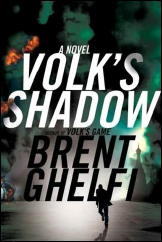
That said, an early flashback within a flashback structure is a bit confusing, and though the writing is certainly good, I’m not always a fan of first person present tense narrative in a book this long. It does have some immediacy, but it doesn’t lend itself to much outside of action scenes.
I’ll be looking for the earlier books in the series and later ones. Volk, Valya, his ally the General, and American NSA operative Brock Matthews are interesting characters with believable ties to Volk, and with so many plot absurdities in many modern thrillers, it is nice to find a writer who can still play variations on classic espionage themes like double agents and treason
And Ghelfi can write when he pauses long enough to:
A lonely light hovered far out to sea, little more than an amber smudge blinking in and out of existence through the rain. A fellow traveler in the darkness …Gliding along, wrapped in a brown mantle, hooded by the night.
If Ghelfi can find a balance between the well written action scenes, the complexities of plot, and that kind of evocative writing he is going to be a thriller writer to watch. He is already one to read.
The Alexei Volkovoy series —
1. Volk’s Game. Henry Holt, hc, 2007; Picador, trade pb, Aug 2008.
2. Volk’s Shadow. Henry Holt, hc, 2008; Picador, trade pb, Feb 2010, as Shadow of the Wolf.
3. The Verona Cable. Henry Holt, hc, 2009.
Sat 12 Sep 2009
REVIEWED BY GEOFF BRADLEY:

JOEL TOWNSLEY ROGERS – The Red Right Hand. Simon & Schuster, hardcover, 1945.
First published in New Detective Magazine, March 1945. Reprinted many times, in both hardcover and soft. Shown: Pocket 385, pb, 1946; Dell D203, pb, Great Mystery Library #9, 1957.
It’s been a while since I despaired of catching up with all the books I would want to read so I have piles of books by old favourites that I haven’t yet got around to, books that I have acquired over the years meaning to try, and new books whose descriptions seem tempting for one reason or another.
This fell into the second category, an impossible crime story that comes highly recommended from some quarters including that indefatigable searcher of impossible crime themes, Bob Adey.

Indeed it was a visit from Bob, who persuaded my son to try the book, even finding a copy in a local second-hand book shop, that led to me finally getting around to it.
I had heard that it was a difficult book to read, that the language was turgid and the action was slow-moving, but in fact I was soon into things and though the layout was rather unusual it never lost my interest.
The story is told by Harry Riddle, a medical doctor, starting with him sitting at the desk of Adam MacComerou in the wilds of Connecticut recounting the story of what has happened in order to try make sense of it.

His recollections are not in chronological order as he muses over what he has been told: the story of Inis St. Erme, a rich young man, and Elinor Darrie, his bride to be, who are driving overnight to Vermont in order to be married, and how a tramp that they give a lift to kills St. Erme and drives off creating much mayhem before impossibly disappearing in the region of MacComerou’s house.
Finally the story catches up to current time and Riddle’s writings finally allow him to explain what has happened.
There would appear to be a few coincidences abounding, unless I’m missing something here, but the denouement is comprehensive and clears up the mysteries pretty well.
An unusual style, but I thoroughly enjoyed the book and I’m glad I can now add it to my list (still being compiled) of books read.
« Previous Page — Next Page »










